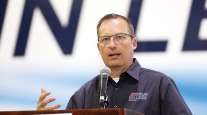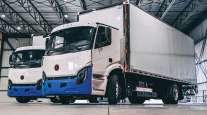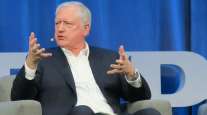Senior Reporter
More BEV Last-Mile Deliveries Eyed Once Charging Expands

[Stay on top of transportation news: Get TTNews in your inbox.]
LONG BEACH, Calif. — An electric last-mile surge is coming. Battery-electric vans and medium-duty trucks will claim a predominant role in goods landing at the front door. The charging infrastructure those vehicles will require must expand, too. And that key step is largely unfamiliar to fleets and local permitting officials alike, experts said.
Industry representatives discussed these changes during the session on Electrifying the Last Mile: An Opportunity Across Weight Classes at Advanced Clean Transportation Expo, which was Aug. 30-Sept. 2.
As the event unfolded, happening elsewhere in the U.S. were multiple wildfires and a powerful hurricane, on the heels of several record heat waves, all of which many attribute to worsening climate change.
Some of America’s largest companies — including Walmart, Amazon, GM and FedEx — are deliberately moving toward carbon-neutral operations, speakers said. But time is running out to eliminate extensive greenhouse gas emissions from trucks, especially, industry executives emphasized throughout ACT Expo.

Aneja
“We are at a tipping point. It is time to act,” said Rakesh Aneja, head of eMobility for Daimler Trucks North America.
Meanwhile, there is a lot of confusion about EV charging.
“People say I can get a [BEV] in six months, or whatever, but I can’t get charging [infrastructure] for two years,” said Paul Rosa, senior vice president of procurement and fleet planning for Penske Truck Leasing.
Rosa moderated the last-mile session.
“Will charging be depot-based or public?” he asked.
“[For fast charging,] if you are doing anything, and it is not on your land that you own completely, it takes anywhere from 10 to 24 months from when you have the idea,” EVgo CEO Catherine Zoi said. “The actual construction process takes four to eight weeks. That’s pretty easy.”
EVgo is the nation’s largest public fast-charging network for EVs and the first powered by 100% renewable electricity.
The EVgo team is poised and ready to share our industry-leading fleet electrification experience with attendees of this year's Advanced Clean Transportation Conference in Long Beach, CA. Join us at booth #1501 to talk about charging solutions for your fleet!#EVgo @ACTExpo pic.twitter.com/niLsG8xi0W — EVgo Fast Charging Network (@evgonetwork) September 1, 2021
Zoi noted many companies are doing important last-mile work that may only have as many as 30 vehicles in their fleet.
“They may not have the footprint at their base to install charging,” she said. “So they may want to share a charging hub.”
Whatever process is needed to build out charging infrastructure, it is not scary, she said.
“But no one is used to it yet,” she added.
As soon as you start thinking about buying an EV, she added, start planning for the infrastructure.
Generally, there is no one in any local government jurisdiction across the country who is even “kind of in charge” of electric vehicle-charging infrastructure, Zoi said.
Many truck makers are preparing to offer consulting services to help customers work through the details of moving to an electric fleet.
John Pfeifer pres/CEO with Oshkosh says his company has been building electric vehicles for over 20 years and will leverage that technology/experience to electrify the entire @USPS delivery fleet over the next 10 years.#ACTExpo pic.twitter.com/BGYWF48n5d — Jack Roberts (@By_JackRoberts) August 31, 2021
Having infrastructure in place will be “the impetus and motivation” for a customer to go into this electric last mile, Oshkosh Corp. CEO John Pfeifer said.
Oshkosh recently was awarded a contract to supply the U.S. Postal Service with between 50,000 and 165,000 delivery vehicles.
The announcement noted the vehicles will be equipped with either fuel-efficient internal combustion engines or battery-electric powertrains. They are intended to be capable of retrofits to keep pace with advances in electric vehicle technologies.
Pfiefer said the Postal Service’s goal was for all of the new vehicles to be zero emissions in 10 years.
One point from a driver’s perspective, BrightDrop CEO Travis Katz said, is the benefit of regenerative braking — or recapturing kinetic energy to recharge the battery.
“That lets you have one-pedal driving, when it’s set,” he said. “That is really amazing once drivers get used to that [using one pedal to accelerate then letting it up to brake].”
The BrightDrop EV600 recently made its national TV debut alongside @FedEx! Like FedEx, we are committed to an all-electric future, and we’re thrilled to be helping the company reach its sustainability goals. Check it out: pic.twitter.com/QnJMXEau36 — BrightDrop (@brightdrop) June 4, 2021
BrightDrop is a new division of GM that will build an “ecosystem of electric first-to-last-mile products,” according to GM.
FedEx Express is an early customer for 500 of BrightDrop’s EV600 delivery vans, which have a 250-mile range.
Boris Kort-Packard, FedEx chief engineer of global vehicles, said an electric vehicle in and of itself was not the magic answer.
“You have to understand your own fleet data, and the applicability,” he said, “and recognize that this really does make sense.”

Fleet managers find that healthy, happy drivers are key to business success. Stephen Kane of Rolling Strong says driver health starts with “being vulnerable enough to listen to somebody that knows about health.” Hear a snippet above, and get the full program by going to RoadSigns.TTNews.com.
After-sales support is needed. So is a parts network to ensure the electric vehicle continues to provide all of the anticipated benefits.
It also has to be the right truck for a fleet’s application.
“We have had companies come to us, and they basically have an electric school bus,” said Kort-Packard. “And we are in the pick up and delivery business with small vans. And they say, ‘but it’s electric.’ ”
FedEx Express is a unit of FedEx Corp., which ranks No. 2 on the Transport Topics Top 100 list of for-hire carriers in North America.
ACT Expo, in its 10th year, set a record with 5,000 attendees. It drew 250 exhibitors.
Want more news? Listen to today's daily briefing below or go here for more info:




